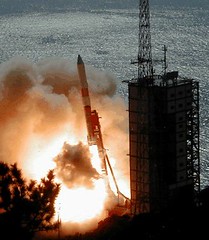
In the late 1980s and early 1990s, the X-ray group at Goddard was developing a new type of X-ray spectrometer called an X-ray microcalorimeter. The X-ray calorimeter had originally been slated to be an instrument on NASA's Advanced X-ray Astrophysics Facility (AXAF). In 1992, however, AXAF was split into two satellite missions – one would primarily perform high-resolution imaging (ASAF-I)*, the other primarily high-resolution spectroscopy (AXAF-S). The X-ray calorimeter was to be the headliner on AXAF-S.
Around the same time, Japan's Institute of Space and Astronautical Science (ISAS) was developing their next X-ray satellite, Astro-E. Given the success of the collaboration on the ASCA mirrors, the Goddard mirror group was again involved in collaborating on the Astro-E mirrors. In addition, ISAS wanted a high-resolution X-ray spectrometer onboard Astro-E. It seemed natural for NASA and ISAS to pool their efforts. So NASA agreed to provide one of Astro E's instruments in addition to collaborating on the mirrors.
Astro-E was launched in February 2000, but one of the rocket stages did not fire properly, and the satellite did not make it into orbit. This was a devastating setback for both the ISAS and NASA teams.
The NASA and ISAS teams, however, did not let the loss of Astro-E get them down for long. The Goddard X-ray calorimeter team wanted another chance to see their instrument work in space as soon as possible. At the same time that Astro-E failed to make orbit, NASA had an open proposal opportunity for small-scale satellites, but proposals were due one week after the failed launch. Normally such a proposal would take months to develop. The Goddard X-ray calorimeter team began writing the day after the failed launch and managed to submit a strong proposal by the deadline – strong enough that the proposal was accepted.
In the meantime, the ISAS team also proposed to re-fly Astro-E with essentially the same main instruments, but updated as technology would allow. The ISAS proposal was also accepted. Following ISAS's approval to re-fly Astro-E, the Goddard X-ray calorimeter team requested that NASA morph their small-scale satellite project into a re-flight of Astro-E. ISAS and NASA agreed, and the new observatory would be known as Astro-E2 during it's development.
This time, the launch of Astro-E2 went off without a hitch in July 2005. Upon launch, the observatory was re-named “Suzaku”. Unfortunately for the Goddard instrument team, the X-ray calorimeter lost its liquid helium coolant shortly after launch. The instrument must run at a very cold temperature, and without its coolant, it could not operate properly.
Not all was lost, however. Suzaku's other two instruments have operated well over the satellite's lifetime, leading to many exciting discoveries. Check out the Suzaku News blog pages to learn about some of those discoveries.
NASA and Japan Join Together for X-ray Astronomy: ASCA
-
Continuing the Collaboration: Astro-H